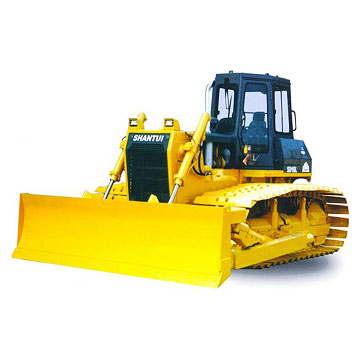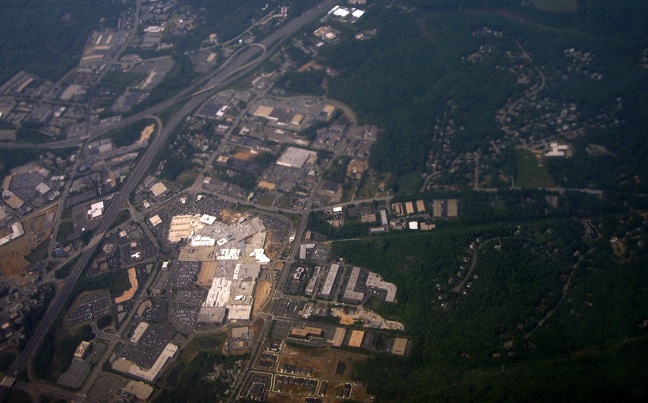Adam Rome
The Bulldozer in the Countryside: Suburban Sprawl & the Rise of American Environmentalism
![]()
“The environmental cost of home building rose sharply after 1945.”
Bulldozer in the Countryside, p. xi.
Contents | Themes | Summary | Question | Sources
Countryside in a Maryland suburban development from a bird's-eye view, 2008.
- Introduction. 1-14.
- 1. Levitt’s progress: the
rise of the suburban-industrial complex. 15-44.
- 2. From the solar house to
the all-electric home: the postwar debates over heating & cooling. 45-86.
- 3. Septic-tank suburbia: the problem of waste disposal at the metropolitan fringe. 87-118.
- 4. Open space: the first
protests against the bulldozed landscape. 119-152.
- 5. Where not to build: the
campaigns to protect wetlands, hillsides, and floodplains. 153-188.
- 6. Water, soil, and wildlife: the federal critiques of tract-house development. 189-220.
- 7. Toward a land ethic:
the quiet revolution in land-use regulation. 221-254.
- Conclusion. 255-270.
![]()
Is the postwar transformation of American landscape by the shifting of a majority residents from urban to suburban living the greatest change in U.S. history, involving as it did a base population that grew from 131 to over 275 million people in fifty years?
![]()
I. Levitt’s Progress: The Rise of the Suburban Industrial Complex
Case study
- Levittown, as an example of mass production and the rise of the suburban-industrial complex
- Macro-economic importance of homebuilding
- laying the foundations for a Consumer Society dependent on consumption of water energy & landscape
- Lakewood Park, California.
- Mass production
- FHA loan guarantees
- Zoning from the Department of Commerce (1928, model zoning act) to segregate uses
“But the state of the nation’s housing did not become a national issue until 1921, when Herbert Hoover became Secretary of Commerce, Hoover’s interest in housing went beyond the conditions of tenements and slums. He believed the widespread home ownership was ‘the foundation of a sound economy and social system,’ and he argued that the structure of the housing industry made home ownership impossible…”
p. 19.
- Too many renters
- Too many inefficiencies in the home building industry
- Public-private partnership to promote home ownership – Model zoning ordinance 1920s
Success was in 1925: 937,000 housing starts
1. Hoover in the height of the depression in 1931, called for easier home mortgages and “call for mass-produced housing” – revitalize building!
2. One third of the nation in 1920s boom period lived in substandard housing
3. Edith Wood, social progressive reformer, called for direct government action
pp. 19-25.
“From the first, Roosevelt understood the macroeconomic importance of the home building industry” and wanted a “program to stimulate construction.”
Passed the National Housing Act of 1934
Created Federal Housing Authority, FHA to guarantee 20 year fixed term mortgages at 80% of the homes value.
p. 28.
FHA often supplied “conditional commitment” to large-scale developments
Home appliance industry responded, after the war to fill the homes with conveniences – refrigerators, radios, stoves, home heating, and “indoor” plumbing.
What is a suburban industrial complex? Godfrey Hodgson
"...the production of houses, automobiles, electrical devices, schools, and hospitals went hand in hand. Because the cheapest and largest tracts of land lay at the urban fringe, the residents of postwar subdivisions and suburbs depended on the automobile for transportation. Nearly nine of ten suburban families owned cars, in contrast to just six of ten urban households , and a much higher percentage of of suburban families had two cars."
√ automobile production jumped 2 million 1946 – 8 million in 1955
√ "boosted sales of household goods." .... "consumer spending increase 60 percent, but the amount spent on furnishings and appliances rose 240 percent"
√ "lawn mower sales jumped nearly ten-fold" 139,000 (1946) 1.3 million (1951)
√ "governments built thousands of roads, schools and hospitals."
pp. 42-43.
Godfrey Hodgson: wrote "the fusion of demographic trends, government policy, and business interests into something like a suburban industrial complex."
"Like so many vital elements of the postwar economy,...the building boom came at considerable environmental cost . . . . the energy-wasting design of the typical postwar home."
"new way of building"
p. 43.
Consequences"The sprawl of suburbia consumes more land now than ever before. According to the U.S. Department of Agriculture, the nation lost almost 1.4 million acres a year to development from 1982 to 1992. In the mid 1990s, the rate more than doubled , to nearly 3.2 million acres a year. The rush of development in the top five growth states alone accounted for the loss of more than a million acres a year. That is roughly the total for the entire nation in the 1950s, when the first critics of the bulldozed landscape began to call for land-saving methods of building."
pp. 264-265.
The total area of the USA is 3, 718, 695 square miles which is 2, 379, 964, 800 acres.
“And that is, 80 percent of us – about 220 million people – live on just 3 percent of the U.S.A.” Eric O’Keefe, editor of The Land Report magazine, publisher of the report.
Contents | Themes | Summary | Sources

2. The Gentle Killing of a soft energy path
“Designed by architect George Keck to receive a maximum amount of the sun’s heat in winter and a minimum amount in summer, the Duncan’s solar home saved money and resources. Even on the coldest January days, the magazine announced, the couple seldom had to turn on the furnace. This was indeed a home to grip ‘the imagination of postwar thinkers and builders.’ “
p. 45.
“Neither the solar house nor the all-electric home ever dominated the housing market in the years from 1945 to 1970, yet the fates of the two types of houses shed light on a profound turning point in American Environmental history. For a few years, many people looked forward to the mass production of energy-conserving homes. By the 1960s, in contrast, the dream of millions of families was the all electric rancher. . . . The high-energy house had become common.”
p. 84.
“the decision to install electric heat was made by builders, not homebuyers, and builders often chose electric heat was cheaper and easier to install, and electric utilities offered builders substantial financial incentives.”
p. 85.
“The postwar decades thus suggest the weakness of a consumer based environmentalism. In the 1950s and 1960s consumers were either unwilling or unable to conserve energy.”
The result in each case [rich or poor] was a dramatic increase in energy consumption.”
p. 86.
Contents | Themes | Summary | Sources
![]()
3. Suburban Septic-tank Utopia?
“Like the automobile and the highway, the septic tank was a key element in the suburbanization of the United States.”
p. 87.
“In 1960, the first census counted nearly 14 million. If the 1945 estimate was close to the mark, then the increase in just 15 years was over 300 percent . . . . roughly 45 percent of the new homes built in those years had septic tanks."
"In metropolitan Phoenix, for example, a 1958 study found that more than 70 percent of subdivision homes had septic tanks."
p. 88.
"If the By the early 1970s, the septic tank problem had become part of a vast environmental crisis that that threatened the well-being of many creatures, not just humans.”
p. 89.
“For the homeowner, the performance of a waste-disposal system was basically a consumer issue, yet the consumer's perspective only took in a handful of environmental problems."
"...but even in the worst case, the typical homeowner did not worry about the long-term environmental costs of septic-tank use."
p. 116.
"...the septic tank was not just a waste disposal technology. It was a mechanism for facilitating the construction of single-family homes in the suburbs, and so it furthered a number of widely shared goals.
1) "The septic tank supported a popular domestic ideal"
2) "It increased the opportunity for people to profit from one of the great American paths to wealth–real estate speculation."
3) "the septic-tank helped to stimulate economic growth.
"Even after the federal government set out to control water pollution, the fundamental dilemma of septic-tank regulation persisted."
p. 117.
" The argument for development remained powerful.”
p. 118.
Contents | Themes | Summary | Sources
![]()
4. Open Space–the earliest protests
“A large number of Americans became concerned about the transformation of the landscape.”
p. 119.
“The open-space issue was rooted in the profound transformation of the building industry during and after World War II. “
Movement from 5.9 % of the nation’s land was urban areas in 1950 to 10.9% in 1970.
“A million more acres every year – a territory larger than Rhode Island.”
p. 120.
“by the late 1960s the effort to preserve open space and the environmental movement had become intertwined in complex ways.” “But the problem proved more intractable...”
“the result was a new sense of the environmental irresponsibility of American culture.”
p. 152.
Contents | Themes | Summary | Sources
![]()
“The chief lesson to be learned is that open-space is a functional land-use—open space is not left-over land, or the vacant land, the unused land or the waste land. It is of an equal order of consideration with any kind of development.”
S. B. Zisman, 1965, planner
p. 153.
“The evolving environmental critique of the building industry."
The political response to losses of valuable lands.
p. 155.
Contents | Themes | Summary | Sources
6 Water, Soil, and Wildlife, critics of development
"sign of a new 'urban consciousness' in Washington."
p. 189.
"People should be more careful about building in floodplains."
"Apparently, urban growth made floods more frequent."p. 191.
"The increase in flood potential....""The increase usually was both substantial and rapid. In one California watershed, the impervious surface jumped from about 4 percent in 1945 to 19 percent in 1958. In some suburban areas, the degree of imperviousness eve reached 30 percent."
"With the help of bulldozers, builders eliminated the natural drainage channels in subdivision tracts. They filled in creeks, brooks, and runs to create flat construction sites. In a watershed..."p. 195.
Contents | Themes | Summary | Sources
![]()
"Property rights and the public good"
"Well before the courts took up the land-use cases, however a movement had begun in legal circles to redefine the rights of property." due to "anxiety about the transformation of the metropolitan landscape."
p. 231.
"The recognition that Americans no longer could treat land as a limitless bounty led to a more radical rejection of tradition."
"It is time to change the view that land is little more than a commodity to be exploited and traded."
"We need a land ethic that regards the land as a resource which, improperly used, can have the same ill-effects as the pollution of air and water, and which therefore warrants similar protection."
p. 241.
Ian McHarg, Design With Nature.
Contents | Themes | Summary | Sources
![]()
Nearly one-third of all energy uses in the United States is used to heat and or cool buildings, another third or more for transportation; from these two facts the effects of sprawl due to a popular and widespread demand for single family homes
Ironically, the as the size –meaning the number of children in each household–of completed families fell from 1945 - 2000, the average square footage of single-family homes doubled during those same years.
- Bulldozer: introduction and cases
- Bulldozer: Detailed examples
- Bulldozer: Open Space losses
- Bulldozer: Consequences of conflicts
- Outcomes: Society was "to pay" four "significant" parts "of the costs of production"
![]()
| Necessary links: | |||
|---|---|---|---|
| Air | |||
| Vegetation | 
|
Water | |
| Soil |
What are the different scales of our impact? WEAL |
|
|---|---|
 |
|


